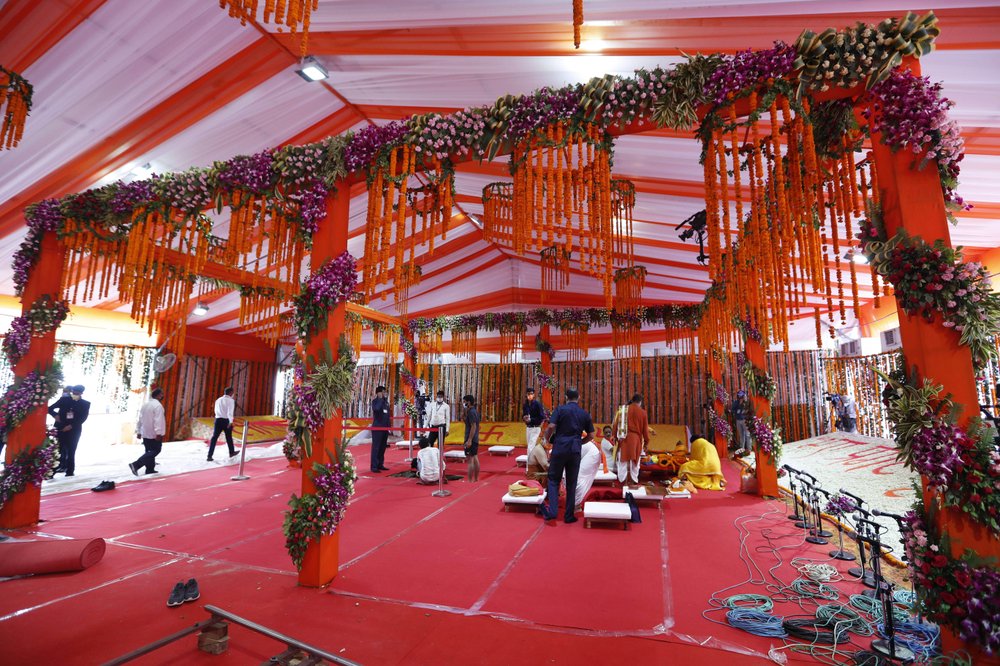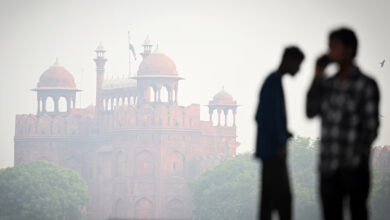
AYODHYA, India (AP) — Despite the coronavirus restricting a large crowd, Hindus rejoiced as Indian Prime Minister Narendra Modi broke ground Wednesday on a long-awaited temple of their most revered god Ram at the site of a demolished 16th century mosque.
Modi offered prayers to nine stone blocks with lord Ram inscribed on it amid chanting of Hindu religious hymns to symbolize the start of construction of the temple, which is expected to take three and a half years.
Modi wore a traditional outfit of a gold Kurta, a long shirt, and white Dhoti, a loose cloth wrapped around his waist, along with his face mask.
“It’s an emotional and historic moment. Wait has been worthwhile,” said Lal Krishna Advani, a 92-year-old leader of the governing Bharatiya Janata Party who was in the forefront of the party’s temple campaign in 1990s.
Organizers said the ceremony was set on an astrologically auspicious date for Hindus but Wednesday also marked a year since the Indian Parliament revoked the semi-autonomous status of its only Muslim-majority state, Jammu and Kashmir.
The symbolism was impossible to miss since Modi’s Hindu nationalist Bharatiya Janata Party had long pledged in its manifesto to strip disputed Kashmir’s autonomy and to build a temple to the Hindu god Ram where the Mughal-era mosque once stood.
The main roads were barricaded and about 3,000 paramilitary soldiers were guarding Ayodhya city, where all shops and businesses are closed. Last week, a priest and 15 police officers at the temple site tested positive for the coronavirus, which has infected 1.9 million people in India and killed more than 39,000.
“Had this function been held on normal days all these roads would have been chock-a-block with people. Millions of people would have come to Ayodhya to witness this historic event,” temple priest Hari Mohan said.
Only 175 religious saints, priests and Hindu and Muslim community representatives were invited to the ceremony.
Water from Indian rivers in 2,000 earthen pots sent by various Hindu temples and Sikh shrines was poured at the site.
The groundbreaking follows a ruling by India’s Supreme Court last November favoring the building of a Hindu temple on the disputed site in Uttar Pradesh state. Hindus believe their god Ram was born at the site and claim Muslim Emperor Babur built a mosque on top of a temple there.
The Babri Masjid mosque was destroyed by Hindu radicals with pickaxes and crowbars in December 1992, sparking massive Hindu-Muslim violence that left some 2,000 people, mostly Muslims, dead. The Supreme Court’s verdict allowed a temple to be built in place of the demolished mosque.
Those invited to the groundbreaking ceremony include Iqbal Ansari, the main Muslim litigant in the Supreme Court case, who now supports building the temple in Ayodhya.
The court also ordered that Muslims be given five acres (two hectares) of land to build a new mosque at a nearby site.
The temple will be around 235 feet (72 meters) wide, 300 feet (91.5 meters) long and 161 feet (49 meters) high with five domes with a total area around 84,000 square feet (7,804 square meters). The complex will also have a prayer hall, lecture hall, visitors’ hostel and museum.
Houses and other buildings close to the temple site in the city of Ayodhya have been painted yellow to recreate the look when the Hindu god Ram ruled there for thousands of years, according to the Hindu epic Ramayana.
“Yellow is an auspicious color. As per Hindu tradition, yellow symbolizes purity and light,” temple priest Mahant Kamal Narain Das said.
Muslims comprise around 14 percent of Hindu-majority India’s 1.3 billion people. The temple-mosque dispute badly divided Hindus and Muslims, often triggering communal clashes.
Prominent Muslims have said the community was resigned to the new reality but fear the new temple could embolden Hindu nationalists to target two other mosques in Uttar Pradesh.
“The Modi government should assure Muslims that Hindu outfits will not ask for the construction of temples in Varanasi and Mathura after demolishing existing mosques there,” said Ansari, the main litigant in the Supreme Court case.
The Gyanvapi mosque in the city of Varanasi is in a temple complex dedicated to Lord Shiva. In the city of Mathura, the Shahi Idgah mosque stands adjacent to the temple complex that marks the birthplace of the Hindu god Krishna. Hindu organizations say both were built over razed temples.
___
Image: Hindu priests prepare the site for a groundbreaking ceremony of a temple dedicated to the Hindu god Ram in Ayodhya, India, Wednesday, Aug. 5, 2020. The coronavirus is restricting a large crowd, but Hindus were joyful before Prime Minister Narendra Modi breaks ground Wednesday on a long-awaited temple of their most revered god Ram at the site of a demolished 16th century mosque in northern India. (AP Photo/Rajesh Kumar Singh)




